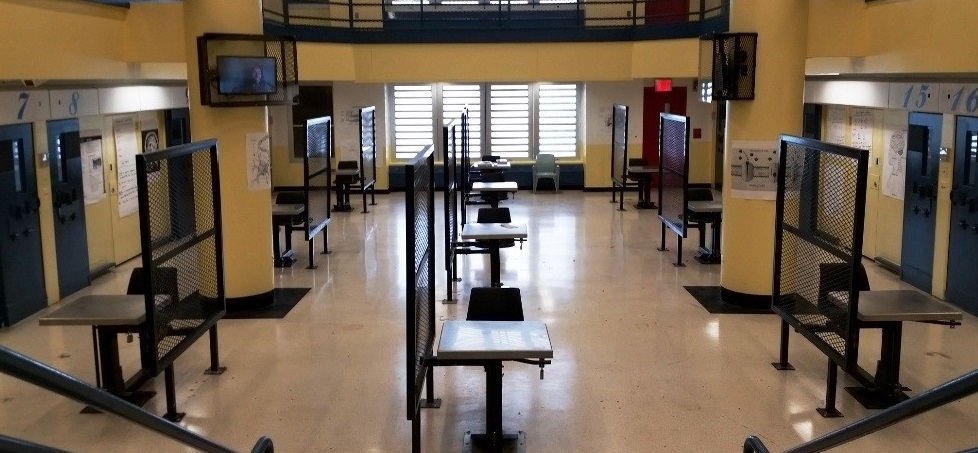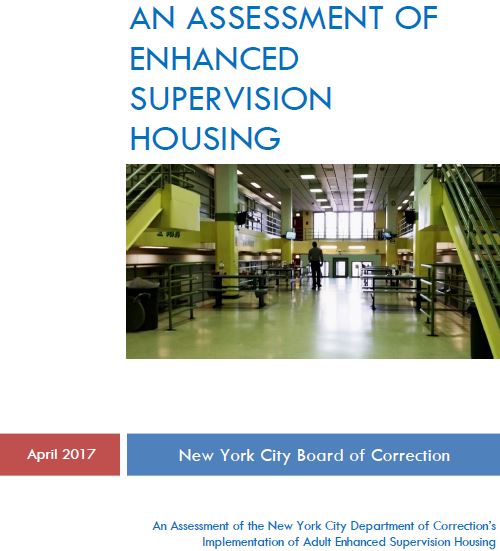
 Board of Correction311
Board of Correction311 Search all NYC.gov websites
Search all NYC.gov websites
Assessments of Enhanced Supervision Housing (ESH) and ESH for Young Adults
An Assessment of Enhanced Supervision Housing
An Assessment of Enhanced Supervision Housing for Young Adults (July 2017)
The Board originally prohibited placement of 16- to 21-year-olds in ESH and tailored the ESH standards to address the challenges posed by, and the needs of, incarcerated adults. However, the Board subsequently on four occasions approved variances from the ESH Minimum Standards that permit the Department to house young adults ages 18 through 21 (YAs) in ESH. The Department’s variance requests have repeatedly cited security concerns and the need for ESH as a housing option for young adults who have perpetrated violence. The Department has opened a young adult-only ESH unit where young adults are restrained to desks for all out-of-cell activities and receive 30-day reviews to assess whether they can be moved to a less restrictive setting. This staff report is intended to build upon the Board’s Assessment of ESH for Adults released in April 2017 and offer a specific analysis of ESH implementation for young adults.
The Board’s April 2017 Assessment identified several areas for improving ESH including: policies and practices related to progression through ESH and periodic reviews, medical care access, lock-out, and steady staffing. Board staff also identified numerous opportunities for improving fairness and transparency in the Department’s implementation of ESH due process. This assessment of ESH implementation for young adults finds those recommendations are equally applicable to the Department’s YA ESH model. Board staff are encouraged by DOC’s efforts to develop policies and a model tailored to the unique needs of the young adult population as well as the Department’s adoption of a more multidisciplinary approach to management. Board staff are also encouraged by the Department’s recent steps toward developing systems for tracking, monitoring, and evaluating ESH.
Despite the Department’s commendable efforts, Board staff remain concerned about ESH for the young adult population. For a variety of reasons, including—lockdowns, the lockout schedule, operational issues related to staffing and management, safety concerns, and a general lack of engagement—most young adults are spending nearly all day locked in their cells rather than the minimum 7 hours provided for under the ESH Standards.2 Most young adults in ESH are restrained to desks when they lock out of their cells, and participation in programming, recreation, and mental health services has been very low, particularly in blended ESH units (units housing adults and young adults). Nearly all young adults in ESH have non-contact visit restrictions imposed for the duration of their time in DOC custody, and very few young adults have progressed to less restrictive housing assignments. Furthermore, the occurrences of slashings and serious acts of violence in units where restraint desks are in use raises serious concerns and warrants further investigation.
To conduct this assessment, Board staff matched available data on individuals placed in Young Adult ESH to various Department-wide data systems and conducted unit observations to get a better understanding of YA ESH’s operational framework. Board staff also reviewed all young adult placements in ESH between September 2016 and March 2017, including all due process records for these placements. Correctional Health Services (CHS) and the Department of Education (DOE) also provided information on the characteristics of and services provided to young adults while housed in ESH.In October 2014. as the Board debated historic punitive segregation reforms, the Department proposed to the Board a new restrictive housing unit, Enhanced Supervision Housing (ESH), that it believed to be a critical part of its punitive segregation reform and violence reduction plans. The Board ultimately approved a modified version of the proposal which created placement criteria, additional procedural safeguards, programming, training, and steady staff requirements. This staff report is intended to inform the Board’s discussion of the effectiveness of ESH at its May 2017 public meeting.
Positive findings from the assessment include that the Department: placed individuals in ESH who met at least one ESH placement criterion, with most placements meeting multiple ESH criteria; provided individuals in ESH timely notice, placement hearings, and written placement determinations; excluded people with known serious mental or serious physical disabilities or conditions from placement in ESH; provided programming and developed a structured approach to programming in ESH; and provided most officers working in ESH 40 hours of specialized training.
While many of the ESH Standards have been implemented and met by the Department, areas for improvement include the policy and practice related to progression through ESH and periodic reviews, medical care access, lock-out time, and steady staffing. Board staff also identified numerous opportunities for improving procedural justice, fairness, and transparency in the Department’s implementation of ESH due process. Finally, the challenges associated with monitoring ESH due to limited data management systems should be reviewed carefully.
The assessment studies the first twenty-two months of adult ESH placements (February 2015 - November 2016) and conditions in ESH through December 2016 via data analysis, interviews with staff and people in custody, observations, and policy reviews.




